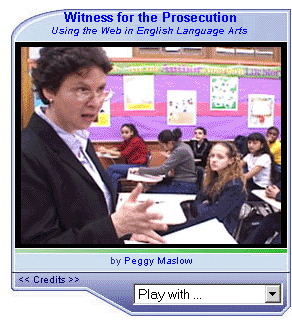| Witness for
the Prosecution: Online Newspaper
Project URL:
http://teachersnetwork.org/teachnet-lab/fklane/pmaslow/witness.htm
See
the video!
 |
How it works:
Students read Witness For the
Prosecution by Agatha Christie. The foreshadowing in the first act
helps identify one main theme--mistakes are made in the justice
system--which, by the way, could include mistakes made by juries, defense
attorneys or their clerks, prosecutors, judges, police, and investigators. |
In Act I, the facts of the case for murder
are presented. Students then read a news article describing a possible
accidental murder. They analyze the news article which should have 7
parts: the headline with a verb, the lead (normal or novelty,) background
details, the 5 w's and h answered, attribution ( the source of all the
facts either quoted or paraphrased), no bias demonstrated by the writer,
and the most important fact according to the writer is first in the
article. Students write a news article using the newspaper article
as a model but with the facts from the play.
Act II contains a dramatic transcript of
the witness's testimony and questions asked by the prosecutor and defense
attorney. A surprise witness for the prosecution appears--the defendant's
so-called wife. Students read a second
news article about a trial with a surprise witness and analyze it. Then
they write a second news article about the trial in the play with a
surprise witness.
Students analyze an obituary article and
write an obituary based on one of the two characters who died in the play
after reading the third and final act.
The fourth article they analyze is a
feature article about how one man was mistakenly found guilty and
sentenced to death because of mistakes made by the prosecution. Students
then write their own feature article about mistakes in the justice system
based on this play.
The fifth article students read is an
editorial about the use of the "heat of passion defense"
accepted by the judge to sentence a husband who murdered his wife for
adultery to 18 months in jail. Students can write an editorial or
commentary or letter to the editor on whether Romaine deserves to be tried
and sentenced for something less than murder one because of the "heat
of passion defense," or they can write on another issue pertaining to
the play including a review of the play. This is an opinion article.
Students post their articles on the class
discussion forum, so that they can learn from each other and also write
for an audience other than the teacher. They also go through several
drafts of their articles.
Students learn how to use Microsoft Front
Page Editor so that they can create online newspapers with at least 3 of
their articles. They also include images of the characters which can be
photographs of students portraying the characters, or images from the
Internet.
These online newspapers are posted on the
school's web site for everyone to see.
Standards:
Technology: Students will use
computer applications for word processing and publishing work to a virtual
classroom space, as well as weave graphics and artistic expression
appropriately into their computer endeavors.
Language Arts: Students produce
written work that makes connections to related topics or information. They
critique their own writing and a classmate's writing, revise drafts, and
publish to a wide audience; analyze data, facts, and ideas to communicate
information; use paraphrase and quotation in order to communicate
information most effectively; read and write editorials; write
advertisements; and participate in a discussion forum.
Materials used:
Students can scan photographs or take
photos with a digital camera. The web-authoring program used was Microsoft
Front Page Editor. Students need an Internet connection to find other
images, to use the discussion forum, and to view the lesson and
suggestions on the Internet. A word processing program is used to type the
newspaper articles based on Witness for the Prosecution.
The Students:
Originally, I chose Witness for the
Prosecution because of the trial scene and the fact that the
majority of students in the three classes I was teaching were also taking
a course in trial practice. Many of the students participated in the NYC
mock trial competition. But for the most part, the student population
could be any high school students. Depending on the students' ability you
could proceed faster or slower, spending more time on vocabulary
development if necessary. It also helps to have students learn basic
journalism skills first such as interviewing, but it isn't vital.
Overall Value:
Students enjoyed being
creative. For their online newspaper, they created ads and used design
elements involving color and images. They learned to analyze newspaper
articles and use the different newspaper article forms themselves. They
had to analyze the plot, character and themes of the play in order to
write good articles. Students learned from each other when they posted
their articles on the discussion forum. These activities helped them to
know the play well.
Tips:
It helps to have students interview each
other first and write articles on each other using quotes and paraphrases. |